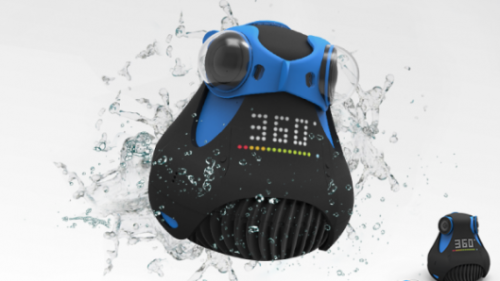The PlexiDrone is an Indiegogo drone project aimed at film makers and aerial photographers.
The system comes in two different configurations; the x4 has four rotors while the x8 has 8, four above and four below. As a result they have different flight characteristics.
- Flight time – 25 mins x4, 20 mins x8
- Speed – 37 mph x4, 42mph x8
- Thrust – 2.35 kg x4, 4.1 kg x8
It’s other specifications include:
- Follow me technology
- Retractable landing gear allowing an unobstructed view below the drone enabling a 360˚ camera gimbal
- SwarmTech allowing multiple drones to be controlled and film the same subject matter
- Object avoidance using ultrasonic sensors which can sense up to 32 ft. (10 m)
- The market version will include a bottom facing ultrasonic sensor which will help control altitude and lower the landing gear when required
- It will also include a front-facing and bottom facing optical flow sensor helping with stability when indoors and without a GPS signal
- The PlexiDrone allows modular payloads including:
- PlexiGCS control App on iOS, Android or Windows
- Snap together construction fits into the PlexiPack or PlexiPack Mini custom made backpack
- PlexiFPV Real-time video which simply snaps onto the PlexiDrone
- The system will work with standard RC (Radio Control) controllers
- 3-axis camera stabilisation
- PlexiDrone 3D Gimbal which carries a GoPro
- PlexiCinema 3D Gimbal which carries mirror-less cinema-quality cameras like the Sony A5000, Sony RX100 III, and Lumix GM5
- Bubl 360˚ Camera
- Sony ActionCam
- Plexidrone
The PlexiDrone comes in a number of buying packages as a quadcopter and as an octocopter.
- The Standard package comes without a gimbal for $699
- The Pro package comes with a gimbal for $799
- The Swarm Pro pack with 3 PlexiDrones and a PlexiHub to control them for $2,499
- The 3D gimbal can be purchased for $159 which will carry a GoPro or other action camera
- The PlexiCinema 3D gimbal can be purchased for $349
- The PlexiFPV first person view system can be purchased for $215
- The system can be upgraded to an octocopter for $199 by replacing the single rotor snap-on arms with dual ones
Potential
Due to the fact that the PlexiDrone is aimed at aerial photography rather than another discipline it is better suited to the recording of Cultural Heritage and Archaeology. As well as having a number of different photographic platforms available it also has technology such as follow me, obstacle avoidance, optical flow sensors and swarm capabilities which add to its potential for recording in different environments. Some of these technologies are only available on the much more expensive DJI Aspire 1.
The retractable landing gear allows for much more freedom of movement in the camera gimbal which can record 360˚ around the horizontal access and 180˚ in the vertical without any of the drone appearing in the photographs.
The snap together construction of the PlexiDrone allows for easy packing into a backpack style storage system which appears easily portable.
The fact that the system has easily interchangeable payloads allows for much more flexibility in recording than other systems. It can carry a GoPro like all of the other cheap drone systems, but can also carry heavier cameras with better optics and higher megapixels allowing greater quality recording and it can also carry the bubl 360˚ camera as well adding 360˚ recording to its abilities.
The swarm capabilities allows multiple drones to record the same subject from different directions, increasing the speed of recording and the amount recorded.
Limitations
Using the swarm capability obviously adds significantly the cost.
Although it can carry more complex digital cameras it cannot carry the heavier high-spec digital SLR cameras.



















































